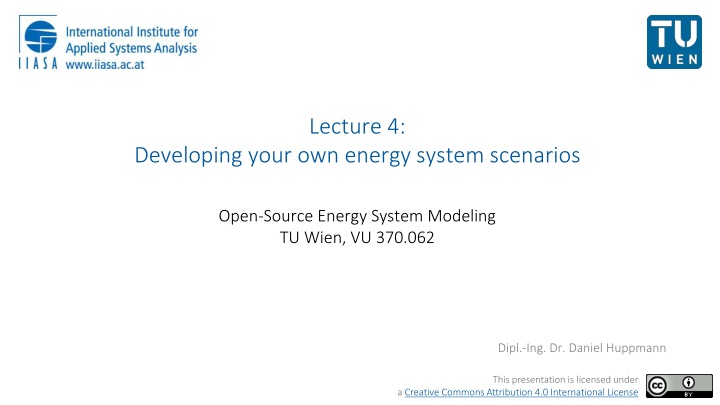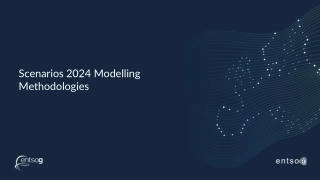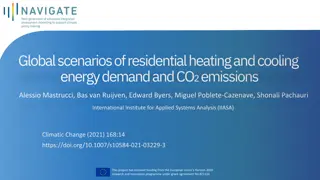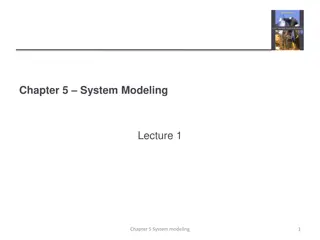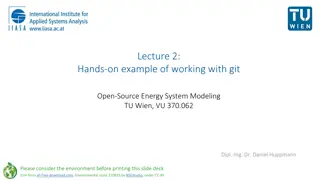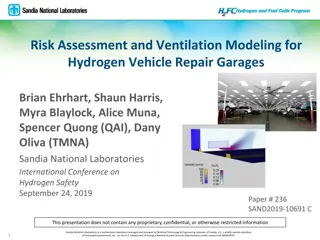Open-Source Energy System Modeling for Developing Energy Scenarios
Exploring the concept of modeling in energy systems, the presentation delves into creating energy scenarios through open-source tools, emphasizing the importance of clear system boundaries and mathematical descriptions. It discusses the process of scenario design, model implementation, and addressing challenges with open-source scientific software while suggesting ways to enhance collaboration and support for such projects.
Download Presentation

Please find below an Image/Link to download the presentation.
The content on the website is provided AS IS for your information and personal use only. It may not be sold, licensed, or shared on other websites without obtaining consent from the author.If you encounter any issues during the download, it is possible that the publisher has removed the file from their server.
You are allowed to download the files provided on this website for personal or commercial use, subject to the condition that they are used lawfully. All files are the property of their respective owners.
The content on the website is provided AS IS for your information and personal use only. It may not be sold, licensed, or shared on other websites without obtaining consent from the author.
E N D
Presentation Transcript
Lecture 4: Developing your own energy system scenarios Open-Source Energy System Modeling TU Wien, VU 370.062 Dipl.-Ing. Dr. Daniel Huppmann This presentation is licensed under a Creative Commons Attribution 4.0 International License
Before we get started... What s a model ? An attempt at a definition (in the context of energy systems): A stylized representation of reality Clear definition of the system boundaries Based on a mathematical description Parametrized and solved numerically In practice, the terms model Mathematical formulation just the equations Scientific software implementing the equations (but without data) modelling framework A model model implemented in a modelling framework including full baseline parametrization A scenario design scenario design or scenario protocol scenario protocol is a narrative and parametrization of assumptions possibly relative to the baseline A scenario scenario is an implementation of a scenario protocol in a model model & scenario scenarioare used for several of the items below: equations modelling framework Open-Source Energy System Modeling, Lecture 4 Daniel Huppmann 3
Introduction: a typical modelling project Open-source tools (can) increase the efficiency of modelling, scenario development, analysis, and writing Time allocated for scenario development and analysis Coding a toy problem More coding Collecting data Collecting more data Calibrating a baseline More calibrating Developing scenarios Working on scenarios Analysis & writing Quality of code review, documentation, etc. over project duration 4
Problems with open-source scientific software There are many concerns that open-source projects deliver sub-par quality compared to closed-source tools List of drawbacks: ? ? ? It s just a question of committed resources Overall, the downsides & risks are (pretty much) the same as a close-source (commercial or academic) project 5
Actual issues of open-source scientific software If the quality of open-source projects depends on resources, how do we make sure that projects get adequate support? A few ideas on how to improve collaboration: Make open-source required by funding agencies Change the expectation in the community Look around for existing projects rather than start from scratch Challenges In particular for early-career researchers, how to get recognition for contributions to other projects? Open-source doesn t mean high-quality scientific software 6
Rationale for best-practice scientific programming Following best-practice principles in your work will give you more time to do better research Modelling and scientific analysis is usually a constant prototyping exercise Just adding one more feature often breaks existing functionality Dependencies (open-source packages) change over time Models and tools are too complex to immediately notice changed behaviour Who has not yet experienced the panic & stress from a model not solving shortly before a deadline ? Following best-practice principles Guards against models and tools failing to work (as expected) Helps you to understand your own thinking a few months later 7
Some practical considerations for starting model development Make a conscious choice concerning the system boundaries of your work Earth system Biosphere Ecosystem (services) Climate system Forestry Fossil resources Renewables Oceans Land use Economy Extraction & Mining Water Transformation Agriculture Electricity sector Air quality Human needs Demand Sector Food Demand Health & Poverty Mobility, Lighting, Heating/Cooling, ... Energy system Open-Source Energy System Modeling, Lecture 4 Daniel Huppmann 8
Relevant open-source energy modelling frameworks There are numerous well-maintained options don t start from scratch OSeMOSYS: https://osemosys.org GENeSYS-MOD: http://www.osemosys.org/genesys-mod.html MESSAGEix: https://docs.messageix.org PyPSA: https://pypsa.org Calliope: https://callio.pe Spine: https://www.spine-model.org All of these frameworks have tutorials, examples, active user support via a forum, Please don t start a new model! Open-Source Energy System Modeling, Lecture 4 Daniel Huppmann 9
Part 2 A high-level overview of the open-source energy system model MESSAGEix Open-Source Energy System Modeling, Lecture 4 Daniel Huppmann 10
The MESSAGEixframework: Goals and Vision An integrated modeling platform for x-cutting analysis An effort started in 2016 and still ongoing... Goal: Develop a platform for streamlined modeling using state-of-the-art tools for data processing, building versatile & powerful mathematical models, applying best practice of collaborative research Vision: Facilitate integration of models & scientific analysis ... between different disciplines and fields including economics, engineering, geophysical, and social sciences ... across spatial and temporal levels of disaggregation ... while guaranteeing the highest level of transparency and scientific reproducibility for a wide audience Key features of the ix modeling platform Open-Source Energy System Modeling, Lecture 4 Daniel Huppmann 11
The MESSAGEixframework: Data management A central data management warehouse Good data management is crucial for modeling & scientific analysis: version-controlled and traceable input data for model development reference data for calibration and verification efficient workflows based on standardized data processing tools and a common data interface Open-Source Energy System Modeling, Lecture 4 Daniel Huppmann 12
The MESSAGEixframework: Database backend Supported by a high-performance database architecture The platform... is based on a Java interface as gateway to the data supports both an ORACLE database backend for high-performance, collaborative modeling and local, file-based databases for getting started or working on the fly Open-Source Energy System Modeling, Lecture 4 Daniel Huppmann 13
The MESSAGEixframework: Integration with GAMS Connected to high-performance numerical programming The platform has an interface to GAMS, a versatile software for mathematical programming and optimization. MESSAGEixis the first model fully integrated with the ix modeling platform... Open-Source Energy System Modeling, Lecture 4 Daniel Huppmann 14
The MESSAGEixframework : Scientific programming Interfaces to scientific programming for advanced users In [1]: import ixmp In [2]: # launch the IX modeling platform using the local default database mp = ixmp.Platform(dbtype='HSQLDB') In [3]: model = "Austrian energy model" scen = "baseline" annot = stylized test scenario" require('Rixmp') #----------------------------------------- # load package scenario = mp.Scenario(model, scen, version='new', annotation=annot, scheme= MESSAGE ) #----------------------------------------- # specify the model and scenario name # launch the IX modeling platform mp <- Platform() In [4]: horizon = range(2010, 2070, 10) firstyear = horizon[0] model <- "canning problem" scen <- "standard In [5]: scenario .add_set("year", horizon) scenario .add_cat("year", "firstmodelyear", firstyear) #----------------------------------------- # load a datastructure from the database In [6]: country = "Austria" ds.add_set("node", country) scenario <- mp$Scenario(model, scen) #----------------------------------------- # retrieve the demand as a dataframe demand <- scenario$par("demand") Open-Source Energy System Modeling, Lecture 4 Daniel Huppmann 15
The MESSAGEix framework: Collaborate research Geared towards best-practice in collaborative research The platform facilitates collaborative model development through comprehensive data version control by moving to script-based data processing & analysis using full version control of all model codes and scripts implementing continuous integration automated testing of new features to ensure stable code base Open-Source Energy System Modeling, Lecture 4 Daniel Huppmann 16
The MESSAGEixframework: Documentation Implementing tools for comprehensive documentation The framework ensures transparency and intelligibility through auto-documentation of all codes & packages on readthedocs.org Documentation of all scientific programming packages using sphinx Documentation of the mathematical equations generated automatically from mark-up in the GAMS code Open-Source Energy System Modeling, Lecture 4 Daniel Huppmann 17
The MESSAGEixframework: Interactive web user interface An intuitive gateway to modeling data for researchers and a wider audience The IAMC 1.5 C Scenario Explorer presenting an ensemble of pathways supporting the IPCC SR15 assessment is powered by the web user interface of the ix modeling platform Visit the Scenario Explorer at https://data.ene.iiasa.ac.at/iamc-1.5c-explorer Special Report on Global Warming of 1.5 C (IPCC SR15, http://www.ipcc.ch/report/sr15/) Open-Source Energy System Modeling, Lecture 4 Daniel Huppmann 18
The MESSAGEixframework: Interactive web user interface An intuitive gateway to modeling data for researchers and a wider audience Open-Source Energy System Modeling, Lecture 4 Daniel Huppmann 19
The MESSAGEixframework Facilitating transparency and reproducibility of research Open-Source Energy System Modeling, Lecture 4 Daniel Huppmann 20
Working with the MESSAGEixframework Practical considerations where MESSAGEixdiffers from other frameworks Installation: When installing public release versions via pip or anaconda, you don t need to worry To get the bleeding-edge developments, make sure that you install the corresponding branches from the GitHub repositories ixmp and message_ix Known issue on Mac: versioneer is sometimes confused, delete installation from site-packages directory manually if necessary Your scientific workflow: Don t re-run your scenario assessment notebooks over and over again, because this will create a new scenario instance in the database every time Instead, remove the `version=new` argument to load an existing scenario and adapt the script accordingly Open-Source Energy System Modeling, Lecture 4 Daniel Huppmann 21
Working with the MESSAGEixframework Practical considerations where MESSAGEixdiffers from other frameworks Integration with GAMS: The GAMS code is installed (copied) to the Python site-packages directory, so if you make changes in your git folder, it won t have any effect on your model run This actually makes a lot of stuff simpler for the Python installation (say @gidden and @khaeru) But you can set your git folder as the model folder (i.e., where the message_ix package looks for the MESSAGEix-GAMS code) using this command line interface (CLI): $ messageix-config --model_path /path/to/model Open-Source Energy System Modeling, Lecture 4 Daniel Huppmann 22
Part 2 How to start developing your own energy system scenarios? Open-Source Energy System Modeling, Lecture 4 Daniel Huppmann 23
Considerations for developing a new (energy system) model What do you need to build an energy system A reference energy system (RES) The technologies, commodities, levels Regional specification Time horizon Assumptions (projections) Costs (investment, capacity, variable) Demand for energy and other commodities Bounds on trade, diffusion of new technologies, etc. Policies on emissions (taxes, bounds) and sustainable development policies To make learning MESSAGEix more fun, we developed a suite of tutorials based on the TV show Game of Thrones Open-Source Energy System Modeling, Lecture 4 Daniel Huppmann 24
Part 3 Some considerations on modelling Open-Source Energy System Modeling, Lecture 4 Daniel Huppmann 25
More practical considerations for starting model development Choose an appropriate methodology for the research question at hand Commonly used methodologies: Optimization: determine the system that is optimal according to a metric Equilibrium: determine the system as a result of interacting agents Simulation: determine the system given some decision rules Dealing with uncertainty: Deterministic optimization (perfect foresight): all future states (exogenous parameters) are known at the beginning of the model horizon Stochastic optimization: all future states along an uncertainty tree are known, including probabilities of each branch Myopic (rolling horizon) optimization: decisions in period y are taken under some assumptions about the future; move to period y + 1 and repeat, with (possibly altered) assumptions about periods [y + 2, ... ] Open-Source Energy System Modeling, Lecture 4 Daniel Huppmann 26
Yet more practical considerations for starting model development There are many issues that a self-critical modeller should consider... Model uncertainty: Is the approach appropriate? Are results dependent on the methodology? Parameter uncertainty: How much confidence can you have on input assumptions? Model horizon and level of temporal/spatial disaggregation: What is the intended scope of analysis? Beware of the end-of-horizon -effect! Model simplifications for numerical tractability and comprehensibility: What are appropriate trade-offs between having a high level of detail vs. loosing focus? E.g., variable renewables require infrastructure for system stability assumption or result? System boundaries and model closure: Are the assumptions to close the model valid? E.g., for a national electricity model, you need to make assumptions about import/export Open-Source Energy System Modeling, Lecture 4 Daniel Huppmann 27
Methods to evaluate the robustness of results Think hard about testing your model behaviour Methods for validation: Sensitivity analysis: Structured variation of key input parameters to understand the impact on results Relatively easy to do, but you can never do sensitivity assessment for all parameters... Multi-criteria analysis: Include multiple dimensions in the objective function, solve model with different weights Requires some work, still prone to modelling artefacts Modelling to generate alternatives Re-solve a model to get a different solution within some additional bounds Very elegant, but requires substantial effort to implement Further reading: Joseph F. DeCarolis. Using modeling to generate alternatives (MGA) to expand our thinking on energy futures. Energy Economics 33(2):145-152, 2011. doi: 10.1016/j.eneco.2010.05.002 Open-Source Energy System Modeling, Lecture 4 Daniel Huppmann 28
Thank you very much for your attention! Dr. Daniel Huppmann Senior Research Scholar Energy, Climate, and Environment Program International Institute for Applied Systems Analysis (IIASA) Schlossplatz 1, A-2361 Laxenburg, Austria huppmann@iiasa.ac.at @daniel_huppmann @daniel_huppmann@mastodon.social www.iiasa.ac.at/staff/daniel-huppmann This presentation is licensed under a Creative Commons Attribution 4.0 International License
